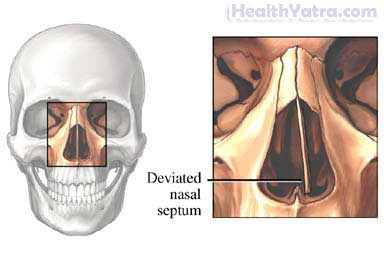Definition
Rhinoplasty is a surgery done on the nose. It is done to reshape the nose.
Reasons for Procedure
- To change or improve appearance
- To improve breathing
- To correct an injury or birth deformity
- A septoplasty can be done at the same time to open blocked nasal passages due to a deviated septum

Possible Complications
Complications are rare, but no procedure is completely free of risk. If you are planning to have a rhinoplasty, your doctor will review a list of possible complications which may include:
- Poor healing of the skin
- Unsatisfactory cosmetic result
- Increased risk of nosebleeds
- Infection
- Reaction to anesthetic
- Puncture of septum or collapse of nose bridge (relatively rare)
Factors that may increase the risk of complications include:
- Smoking
- Age—recommended age is after teen growth spurts and before middle age
- Prior nose surgery
- Prior trauma to the nose
- Medical problems
What to Expect
Prior to Procedure
You may be asked to provide a picture of the nose shape you desire. You may also be given a book to look through to choose a nose shape.
Your doctor will likely do the following:
- Blood tests
- Urine tests
- X-rays of the facial bones
- EKG or chest x-ray may be also required
- Take before pictures of your nose
Leading up to your procedure:
- Arrange for a ride to and from the procedure.
- If you are having general anesthesia, do not eat or drink anything for at least 8 hours before the procedure.
Talk to your doctor about your medicines. You may be asked to stop taking some medicines or herbal supplements up to one week before the procedure, like:
- Aspirin or other anti-inflammatory drugs
- Blood thinners, such as clopidogrel (Plavix) or warfarin (Coumadin)
- Gingko biloba or others
Anesthesia
You may have general or local anesthesia. You will be asleep with general anesthesia. Local will numb the area. In this case, you may also be given a sedative. It will help you relax. The type of anesthesia used will depend on your procedure.
Description of the Procedure
There are three main components of the procedure:
Lifting the Skin of the Nose from the Bone and Cartilage
The nose will be injected with a numbing medicine and epinephrine. The epinephrine will prevent excessive bleeding. An incision will be made either inside the nostril or outside the nostril, across the ridge between the nostrils. The skin will then be lifted off the cartilage of the nose.
Remodeling Bone and Cartilage
Depending on the desired outcome, some nasal bone may be removed, fractured, and reset to a new shape. Cartilage may also be trimmed. Other techniques involve placement of tissue grafts (bone, cartilage, or mucosa) from the patient or a donor or a synthetic graft. They will be used to help remodel the shape of the nose. For example, the tip of the nose may be narrowed or raised, or the slope of the nose may be reduced or increased. The shape or size of the nostrils may also be changed.
Redraping Skin Over the New Base
Once the procedure is finished, the incisions will be closed. The skin will be redraped over the new bone structure. The skin will be tightly taped to keep it in place. A protective metal splint will then be applied on the outside of the nose. It will help to maintain the positioning during healing. Either soft plastic splints or gauze packing coated with petroleum jelly will be used as nasal packs. They may also be inserted into the nostrils as support during healing.
How Long Will It Take?
About 2-4 hours
How Much Will It Hurt?
Anesthesia prevents pain during the surgery. There will be some pain for about 1-4 weeks after the surgery. You will be given pain medicine to relieve this pain.
Average Hospital Stay
You will most likely go home on the same day.
Post-procedure Care
To help ensure a smooth recovery:
- For the first few days after surgery, rest in bed with your head elevated to reduce swelling.
- Apply ice packs to your nose during the first two days. This will help to relieve discomfort.
- Take prescription or over-the-counter pain medicines as directed by your doctor.
- Do not blow your nose at all during the first week. Do not blow your nose forcefully for one month.
- Protect your nose from any injury for eight weeks. Do not wear glasses. Be careful when washing your face.
- Ask your doctor about when it is safe to shower or bathe.
- Avoid vigorous exercise for at least three weeks. Avoid contact sports for six months.
- Be sure to follow your doctor’s instructions.
Stitches will be removed after the first week. Nasal packing will be removed after 1-2 days. The splint is worn for 1-2 weeks or more. Numbness, swelling, or bruising of the surgical area and around the eyes should be expected. Expect swelling and bruising to worsen over the first several days after the surgery. You can also expect some bleeding from the nose, headache, and a feeling of nasal congestion. Once the swelling and bruising have diminished, expect full healing in about 3-4 weeks.
Call Your Doctor
After you leave the hospital, contact your doctor if any of the following occurs:
- Signs of infection, including fever and chills
- Persistent elevated temperature
- Redness, swelling, increasing pain, excessive bleeding, or discharge from the incision site
- Pain that you cannot control with the medicines you have been given
- Cough, shortness of breath, chest pain, or severe nausea or vomiting
- Any new symptoms
In case of an emergency, call for medical help right away.
